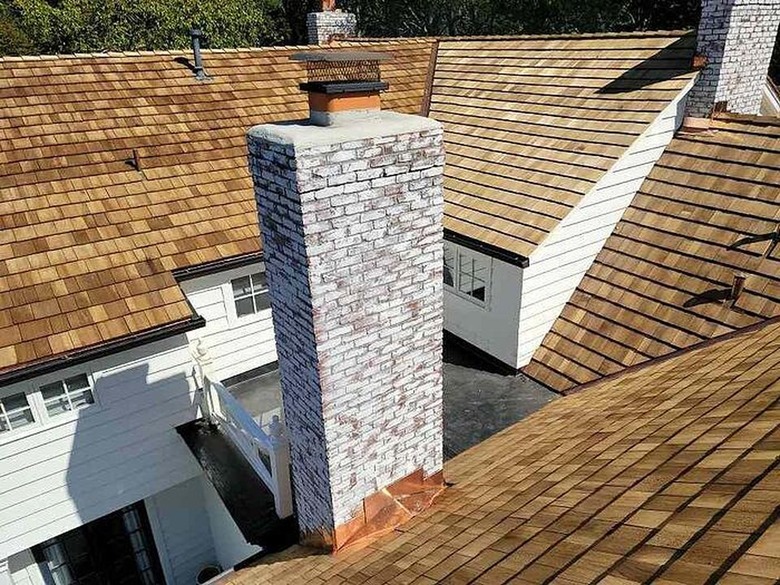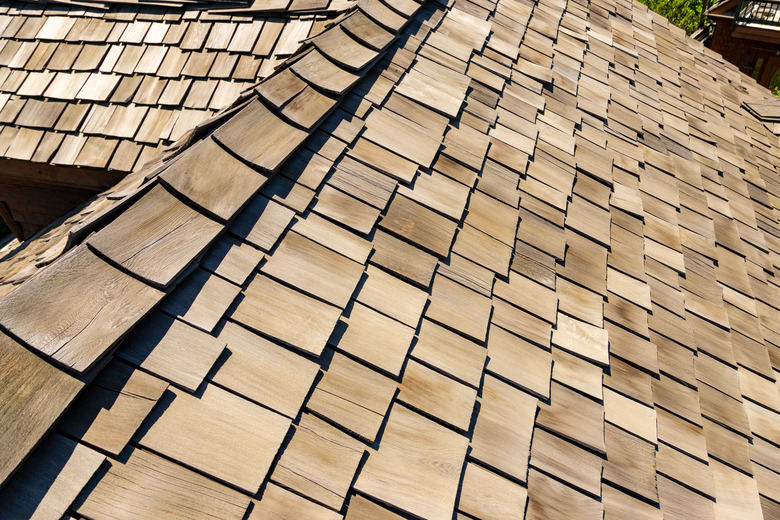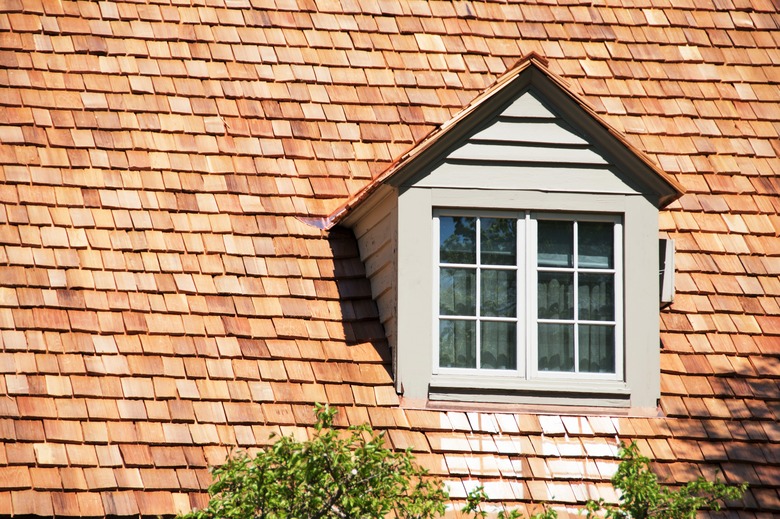Wood Shakes And Shingles: A Cost And Buyer's Guide
We may receive a commission on purchases made from links.
There's something so classic about a wooden roof — whether it's atop a beachside abode or a cozy cottage. But if you're considering upgrading to a wooden roof, what exactly are the costs — and can you tell the difference between wood shakes and wood shingles?
Whichever option you choose, wood gives your home's roof a distinct, timeless look that you can't get with other roofing materials. Exploring the pros and cons of these wood roofing options helps you decide if it's the best material for you.
Wood Shakes vs. Wood Shingles
Wood Shakes vs. Wood Shingles
If someone pointed to a house with a wood roof, would you be able to tell if it has wood shakes or wood shingles? Most people use the terms interchangeably or don't really understand the differences between a wood shingle or shake roof. The subtle difference is in how each is cut and looks.
Wood shingles are cut on both sides into smooth, uniform pieces with each shingle having the same thickness. This creates a more consistent, clean look across the roof.
Wood shakes have a rougher appearance since they are typically hand-split and left rough on top. Every shake is unique because of this. They're typically thicker than shingles and have a more rustic appearance because of the uneven surface.
Wood Roofing Construction
Wood Roofing Construction
Wood shingles start as a block of wood. They're sawn into consistent shingle pieces with a tapered end. Many shingles are now made by machine with both sides cut to create a smooth surface. Shingles tend to have cross-graining, whereas shakes tend to follow the grain more.
Wood shakes are hand-split from a log. Traditionally, they were split using a sharp blade. While still made by hand, they are now made using power equipment. They come in three different types, including:
- Heavy split and resawn: These shake shingles are sawn on the back and split on the front. This gives the roofing materials a highly rugged appearance. The thicknesses range from 3/4 inch to 1 1/4 inches or thicker.
- Medium split and resawn: This option is similar to heavy split shakes, but it's lighter and thinner. It typically comes in 1/2 and 5/8 inch thicknesses.
- Tapersawn: A tapersawn wood shake roof more closely resembles wood shingles since the pieces are cut on both sides, making them smoother than other wood shakes. However, they still maintain more texture and a natural grain compared to shingles. The main difference is that they're thicker than wood shingles, with options including 5/8 inch, 7/8 inch, and 1 inch.
Wood Roofing Grades
Wood Roofing Grades
Wood roofing materials come in four grades, including:
- Grade 1: This is the best-quality option made with edge grain heartwood and has no defects or knots. Edge grain means it's cut perpendicular to the tree's rings. It's typically the most expensive but also the most durable.
- Grade 2: Made with flat grain, which is cut parallel to the rings, with some sapwood, this wood has some knots and defects but only on the part of the shingle that doesn't show. It's ideal for covering exterior walls, reroofing, and starter courses.
- Grade 3: A budget option, this grade also has some knots and defects and uses flat grain and sapwood. It's typically reserved for the walls of sheds and outbuildings or as an undercourse if you're doing a two-course roof application.
- Grade 4: Also called utility grade, this wood isn't designed for roofing. It can work as the undercourse for two-coursed walls.
You can also check for the certi-label from the Cedar Shake and Shingle Bureau. Manufacturers who use the blue labels follow very strict rules for grading wood products. They're also inspected by a third party and accredited by the Cedar Shake and Shingle Bureau.
Wood Types for Shingles
Wood Types for Shingles
Wood roofing can come from a variety of tree species, but cedar wood is one of the most common. In particular, western red cedar is known for being a high-quality, beautiful roofing material that lasts. The most popular wood for roofing, it holds up well against humidity, weather, UV rays, and insects. Other wood species sometimes used for wood shingles and shakes include Alaska yellow cedar, redwood, eastern white cedar, and white oak.
Styles of Wood Roofing
Styles of Wood Roofing
Wood roofing is a traditional option that can work with many different home styles. A wood shingle roof offers a sleeker look that makes it work for a more contemporary look. A wood shake roof adds more texture with a rustic touch, making it ideal for cottages and cabins. Shakes can also give a more historical look to older homes that originally would have had wood shakes.
Cost of Wood Roofing
Cost of Wood Roofing
Wood roofing costs usually fall in the middle of the range for roofing materials. It costs less than slate roofing, but it costs more than asphalt shingles do. Wood shakes usually cost a little more than wood shingles, mainly because they're done by hand versus being machine-made.
You can expect to pay around $5.83 to $9.76 per square foot installed for cedar shingles. If you want cedar shakes, the price will likely fall between $6.07 and $10.31 per square foot. For a 1,700-square-foot roof, that works out to about $9,911 to $16,592 for shingles and between $10,319 and $17,527 for shakes.
Anything that adds complexity or extra work to the installation project increases the pricing. Local roofing contractors can give you estimates based on the specifics of your home. Some of the factors that can bump up the costs include:
- Roof tear-off of old roofing, which usually adds $1 to $2 per square foot
- Disposal fees for old roofing
- A steep roof pitch, which requires more roofing and more safety precautions
- Two-story home that's higher off the ground or landscaping and features near the home that make the roof difficult to access
- Lots of vents, chimneys, and other structures sticking out of the roof that require the roofers to work around them
Life Span of Wood
Life Span of Wood
The life span of a wood shingle or wood shake roof often depends on the type of wood, the material's thickness, and how well the roof is maintained. Being thinner, wood shingles generally don't last as long as wood shakes. You can expect cedar shingles to last around 30 years or more. Cedar shakes typically last 40 to 50 years. Both cedar roof options last longer than asphalt shingles, which usually only last 20 to 30 years.
Review the terms of the warranty, which might vary from around 25 years up to 50 years for the materials. The workmanship warranty varies by roofing contractor. Keep in mind that the warranty doesn't usually transfer when you sell your house. Some roofing companies might allow the warranty to transfer once within a certain time frame.
Roofing Fire Resistance
Roofing Fire Resistance
If you live in an area with a high risk of wildfires, wood shakes and shingles probably aren't the best roofing material for you. They aren't ideal for a fire-resistant home since wood is combustible. Some areas ban wood roofing because of the potential for fires.
You can get wood shakes and shingles that are fire retardant. These shingles undergo pressure impregnation with fire-retardant polymers when they're made to give homeowners fire protection. Options include Class A, Class B, and Class C fire-retardant shingles and shakes, with Class A being the most fire-resistant. To actually reach those fire ratings, your roofer must follow the installation recommendations from the manufacturer.
Roofing Storm Resistance
Roofing Storm Resistance
Because wood shakes are often uneven and don't fit flat against the roof, they leave gaps that can allow wind and rain to blow underneath the shingles, potentially causing damage. Building code requires felt paper between every course to protect your roof against rain. There's still a potential for weather damage with shakes, especially if your roofing contractor cuts corners.
If you live in an area with frequent storms and lots of rain, choosing wood shingles or tapersawn shakes can provide you with better storm damage protection. Since they lie flat, they're easier to install and provide better protection against wind and moisture. If you want medium or heavy shakes, interview roofers thoroughly to ensure they understand and follow the requirements for using roof felt and offsetting the courses correctly.
Impact resistance for wood shakes and shingles helps determine how well they can withstand hail and other impacts that can happen in storms. It's measured by classifications, with Class 4 being the most impact-resistant. Wood roofing typically falls in either Class 3 or 4. Wood shingles have been tested to withstand wind speeds of up to 173 mph, and shakes have shown resistance in winds up to 245 mph.
Roofing Installation Considerations
Roofing Installation Considerations
Wood shingles and shakes both overlap when installed to create more coverage and protection. Shingles are faster and easier to install since they're flat and butt against one another easily. They also don't need the felt layer between each course like shakes do. While wood roofing is easier than some materials to install, it's still better to hire a professional roofer to do the work.
Wood has some unique requirements for installation that can make or break your new roof. Some of those factors include:
- Proper alignment without too much or too little overlap
- Proper ventilation to allow the wood to dry
- Allowing the wood to acclimate before installation
- Using enough nails and the right type of nails based on the geographical area and typical winds in your area
- Proper sealing around roof vents to prevent leaks
- Hand-nailing instead of using a nail gun, which can push the nails too far and crack the wood
Pros of a Wood Roof
Pros of a Wood Roof
Wood roofs offer many advantages compared to other materials. Some of the pros of wood roofing include:
- Improved curb appeal: Wood gives your home a distinct look and can fit historic homes well. It stands out compared to
asphalt shingles, the most common type of roofing. - Easier installation: Cedar shakes require correct felt placement, but wood roofing is relatively easy to install compared to some specialty materials, like slate shingles.
- Ability to repair shingles: If a wood shingle or shake gets damaged, you can often have just the affected shingle replaced. It's best to have an experienced roofer do the work. Other roof materials can be difficult to repair or replace.
- Insulation: Wood shingles can have an insulating effect on your roof to help keep your home at a comfortable temperature.
- Lighter in weight: Wood is a relatively lightweight material compared to some other roofing materials. This makes it easier to get to the roof, and it eliminates the need for structural reinforcement like you need for slate shingles.
Cons of a Wood Roof
Cons of a Wood Roof
The drawbacks of installing wood roofing include:
- Maintenance: Many roofing materials, including metal roof materials and slate shingles, are very low maintenance. A cedar shingle or cedar shake roof requires protective coatings usually every one to three years, which can be time-consuming and costly.
- Insect damage: Wood roofing is a tasty treat for some insects. They might chew the wood or build nests in it. Regular treatments can prevent insect damage.
- Rotting: Moisture soaks into the wood, but sometimes, the bottom of the shingles or shakes don't dry properly if they're not installed correctly. This can cause the wood roofing to rot or warp.


